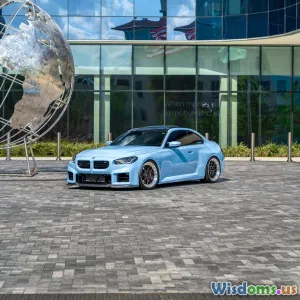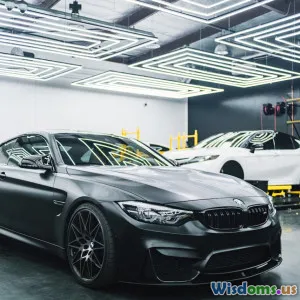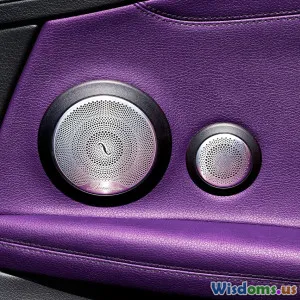From Sketchpad to Showroom: The Making of Iconic Concept Cars
9 min read Explore the captivating journey of concept cars from initial sketches to stunning showrooms showcasing automotive innovation. (0 Reviews)From Sketchpad to Showroom: The Making of Iconic Concept Cars
Concept cars have long been the beacons of innovation in the automotive world. These visionary vehicles preview the future of design and technology, pushing boundaries far beyond conventional production models. But how does a concept car come to life? From an artist’s pencil sketch to the glittering stage at a major auto show, this journey involves an extraordinary blend of creativity, engineering precision, and cultural inspiration. Let’s dive deep into the intricate process that transforms an abstract idea into an iconic piece celebrated on showroom floors worldwide.
Concept Cars: The Intersection of Art and Engineering
Concept cars are more than just prototypes; they’re the physical manifestations of dreams about mobility’s future. Each concept vehicle encapsulates emerging technologies, groundbreaking aesthetics, and sometimes bold social statements. While few concept cars enter mass production unchanged, they set design trends, inspire brand directions, and excite enthusiasts and consumers alike.
Notable examples include the 1964 Ford Mustang Concept, which defined an American muscle car legacy, and the futuristic Mercedes-Benz F 015 Luxury in Motion, which explored autonomous driving and connectivity. These vehicles capture imagination while pioneering advancements like alternative fuels, autonomous systems, or novel materials.
Stage 1: Vision on Paper – The Birth of a Concept
Ideation and Market Research
The journey begins with identifying what the brand wants to convey. Market trends, technological capabilities, and consumer desires shape the overarching theme. Manufacturers often balance radical ideas with feasibility to keep concepts relevant. For example, Tesla’s Cybertruck shattered traditional pickup design norms by emphasizing durable exoskeleton construction and angular aesthetics.
Artistic Sketching
Designers use freehand sketches as the earliest visual language of the car’s personality and function. These sketches communicate proportions, stance, and distinctive features. Renowned designer Steve Rattner once described concept sketches as “the soul of innovation — when creativity is at its purest.” Tools like digital tablets now augment traditional methods, allowing rapid iterations.
Digital Modeling and Virtual Reality
After preferred sketches gain approval, designers create precise 3D digital models using CAD (computer-aided design) software. Virtual reality (VR) can simulate vehicle presence in varied environments, enabling teams to analyze aesthetics and ergonomics from every angle before physical models exist.
Stage 2: From Screen to Structure – Clay Modeling and Engineering
Sculpting the Clay Model
One of the most tactile and celebrated steps in making concept cars is the full-scale clay model construction. This process translates two-dimensional designs into tangible forms. Skilled modelers use industrial-grade clay over a wireframe structure, crafting every curve and crease accurately.
Clay modeling allows designers to study how light interacts with surfaces and adjust proportions fluidly. Icons like the 2001 Dodge Viper Concept showcased in sensuous curves only achievable through scrupulous clay refinement.
Collaboration Across Departments
Simultaneously, engineers start evaluating how futuristic ideas like new propulsion methods or materials can be integrated without compromising feasibility. Early integration between design and engineering teams helps reconcile avant-garde designs with safety, aerodynamics, and powertrain constraints.
Stage 3: Engineering the Unreal – Technical Innovations
Advanced Materials and Powertrains
Many concept cars experiment with novel materials like carbon-fiber composites and lightweight alloys. These materials reduce weight, improving efficiency and agility. Consider the BMW Vision EfficientDynamics concept, which integrated hybrid technology with advanced lightweight engineering.
Moreover, concept vehicles frequently host cutting-edge powertrains, including hydrogen fuel cells, fully electric motors, or even experimental hydrogen-electric hybrids, demonstrating possible solutions for sustainability challenges.
Integration of Futuristic Technologies
Beyond mechanical engineering, concept cars often contain aspirational technology — such as augmented reality dashboards, gesture controls, or AI-driven driver assistance. Tesla’s Model P Concept (hypothetically) incorporates highly intuitive human-machine interfaces, illustrating concepts that inspire future commercial products.
Stage 4: The Showroom Reveal – Bringing Dreams to Life
Fabrication of Functional Prototypes
Creating a show-ready concept typically involves crafting at least one fully functional prototype. Highly specialized fabricators, technicians, and craftsmen collaborate to work in materials ranging from blown glass to precision-machined metal.
Many of these cars, like the Toyota FT-1 Concept, are operational vehicles that demonstrate real performance capabilities, not mere static displays. This functionality allows for impactful presentations during international auto shows, where media and public inevitably dream of owning the future.
The Role of Auto Shows and Media
A concept car’s debut is designed to maximize impact. Events like the Geneva Motor Show, Detroit Auto Show, and Pebble Beach Concours d’Elegance become theaters where brands reveal design philosophies and strategic directions. Media coverage and audience reactions often influence which ideas permeate mass production models.
Case Studies: Iconic Concept Cars and Their Legacy
1. Citroën DS Concept (1955)
Heralded for its radical aerodynamic shape and futuristic suspension technology, the 1955 Citroën DS was a concept that broke away from traditional styling and engineering. Its design inspired numerous aspects of modern car manufacture, proving how concept innovation helps set long-term industry directions.
2. Audi Quattro Concept (2010)
Reviving the legendary Quattro, Audi's concept blended classic design cues with modern performance technology. This concept influenced the re-introduction of the Audi Quattro name into premium sectors, illustrating the enduring power of heritage alongside innovation.
3. Lamborghini Egoista (2013)
An extreme example of personal automotive art, the Egoista was built in celebration of Lamborghini's 50th anniversary. Its design, inspired by fighter jets, showcased aerodynamics, lightweight materials, and sculptural form — representing a standalone expression of the brand's radical spirit.
Conclusion: Concept Cars as Catalysts for Automotive Evolution
From pencil line to illuminated showroom, the making of iconic concept cars is a testament to human creativity and technical prowess. They remind us that the quest for mobility is as much about aspiration as it is about transport. Through paradigm-shifting designs, bold powertrains, and experimental technologies, concept cars articulate visions of what driving might become.
These dream machines challenge perceptions, inspire future possibilities, and keep the world fascinated with the automobile's evolving narrative. Whether it’s the sleek lines captured on a drawing board or the dynamic spotlight on a stage at an international auto show, concept cars are truly where imagination meets engineering excellence.
As we look ahead, the connection between sustainable innovation and captivating design promises even more groundbreaking concepts—inviting enthusiasts, engineers, and consumers alike to witness and participate in crafting the automotive future.
References and Further Reading:
- "Design & Innovation in Automotive Concept Cars," SAE International Journal, 2020.
- P. Braun, "The Art of Automotive Design," Motor Press, 2018.
- "Behind the Scenes: Crafting the Ford Mustang Concept," Ford Motors Archives.
- Mercedes-Benz Media, "The F 015 Luxury in Motion," 2015 auto show documentation.
- Interviews with Steve Rattner, Automotive Design Weekly, 2022.
Rate the Post
User Reviews
Popular Posts




















